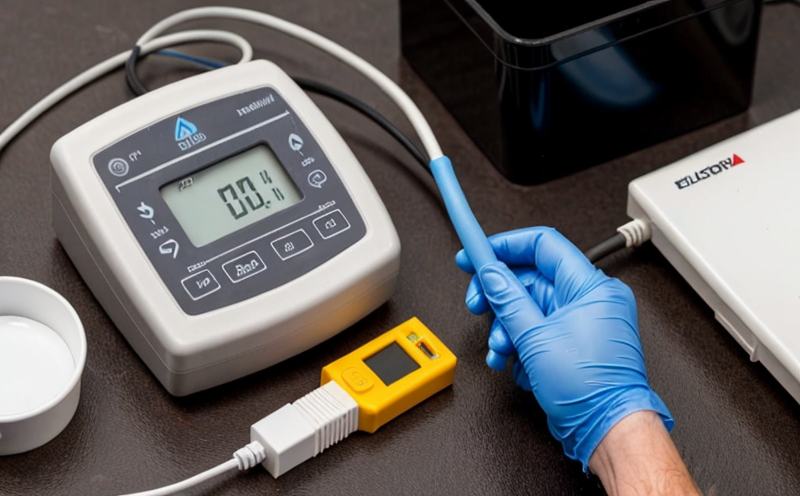BS EN ISO 17475 Electrochemical Potentiodynamic Testing
The BS EN ISO 17475 standard defines electrochemical potentiodynamic testing methods for corrosion protection of metallic materials. This testing method is widely used in the chemical industry, especially for materials exposed to aggressive environments such as acids, alkalis, and salts.
This form of testing involves sweeping a potential from a reference electrode over a range of potentials applied to the specimen material. The resulting current response at each potential provides information on the corrosion behavior of the material under test conditions. This method is particularly useful for evaluating the effectiveness of coatings or surface treatments in preventing metal degradation.
The process begins with careful preparation of the specimens, ensuring they are free from contamination and are representative of the materials to be tested. The specimens are immersed in a test solution that simulates the environmental conditions under which they will operate, such as salt water for marine applications or acid solutions for industrial processes.
The testing apparatus typically includes a potentiostat, a three-electrode system consisting of the working electrode (specimen), a reference electrode, and a counter electrode. The potentiostat controls the potential applied to the specimen while measuring the resulting current flow. This setup allows for precise control over the potential sweep rate and range.
The test data are typically presented in cyclic voltammograms, which plot the current response versus the applied potential. These graphs provide valuable insights into the electrochemical behavior of the material, including anodic and cathodic reactions that contribute to corrosion. The results can be compared against established standards or previous tests for quality assurance.
The BS EN ISO 17475 method is versatile, allowing for the testing of a wide range of metallic materials under various conditions. It is particularly useful in industries where material durability and reliability are critical, such as chemical processing facilities, oil refineries, and marine structures.
| Condition | Description |
|---|---|
| Solution Concentration | The test solution's concentration directly affects the corrosion rate. For instance, higher concentrations of acids or bases can accelerate degradation. |
| Potential Sweep Rate | The speed at which potentials are swept is crucial as it can influence the resolution and accuracy of the data collected. |
Understanding these parameters allows for more accurate testing and interpretation of results, ensuring that materials meet stringent quality standards. This method is not only used in research and development to improve material performance but also in production environments to maintain compliance with industry regulations.
The BS EN ISO 17475 method is a cornerstone of electrochemical testing, providing reliable data for evaluating the corrosion resistance of metallic materials. Its precision and repeatability make it an essential tool in quality assurance programs across various sectors.
Benefits
- Comprehensive evaluation of corrosion resistance under controlled conditions.
- Identification of potential issues early, allowing for corrective actions before product launch.
- Accurate comparison of different materials or coatings using standardized methods.
- Enhanced reliability and longevity of products in harsh environments.
- Supports compliance with international standards such as BS EN ISO 17475.
Customer Impact and Satisfaction
The application of BS EN ISO 17475 potentiodynamic testing has a significant impact on customer satisfaction across various industries. By ensuring that materials used in critical applications meet the highest quality standards, this method helps companies avoid costly failures and recalls.
Customers who rely on our services for electrochemical testing can be assured of the reliability and durability of their products. This not only enhances brand reputation but also builds long-term customer relationships based on trust and consistent performance.
The detailed reports generated from these tests provide clear, actionable insights that guide product development and improvement efforts. This proactive approach to quality control ensures that customers receive products that are not only compliant with industry standards but also meet or exceed their expectations for performance and longevity.
Use Cases and Application Examples
| Application | Description |
|---|---|
| Metallic coatings | Evaluating the effectiveness of different coating types on metallic surfaces. |
| Marine structures | Determining corrosion resistance in saltwater environments for offshore platforms and ships. |
| Petrochemical plants | Assessing materials used in pipelines and storage tanks exposed to aggressive chemicals. |
The BS EN ISO 17475 method is integral to the development, production, and quality assurance processes of companies operating in these sectors. By providing detailed insights into material behavior under various conditions, this testing ensures that products are fit for purpose and capable of withstanding real-world challenges.





